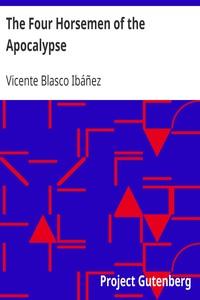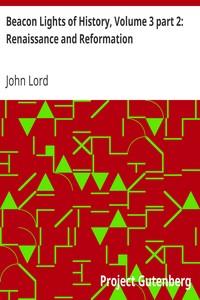Read this ebook for free! No credit card needed, absolutely nothing to pay.
Words: 102891 in 13 pages
This is an ebook sharing website. You can read the uploaded ebooks for free here. No credit cards needed, nothing to pay. If you want to own a digital copy of the ebook, or want to read offline with your favorite ebook-reader, then you can choose to buy and download the ebook.
ESSAYS.
PART FIRST.
"What are you, where did you come from, and whither are you bound?"--the question which from Homer's days has been put to the wayfarer in strange lands--is likewise the all-absorbing question which man is ever asking of the universe of which he is himself so tiny yet so wondrous a part. From the earliest times the ultimate purpose of all scientific research has been to elicit fragmentary or partial responses to this question, and philosophy has ever busied itself in piecing together these several bits of information according to the best methods at its disposal, in order to make up something like a satisfactory answer. In old times the best methods which philosophy had at its disposal for this purpose were such as now seem very crude, and accordingly ancient philosophers bungled considerably in their task, though now and then they came surprisingly near what would to-day be called the truth. It was natural that their methods should be crude, for scientific inquiry had as yet supplied but scanty materials for them to work with, and it was only after a very long course of speculation and criticism that men could find out what ways of going to work are likely to prove successful and what are not. The earliest thinkers, indeed, were further hindered from accomplishing much by the imperfections of the language by the aid of which their thinking was done; for science and philosophy have had to make a serviceable terminology by dint of long and arduous trial and practice, and linguistic processes fit for expressing general or abstract notions accurately grew up only through numberless failures and at the expense of much inaccurate thinking and loose talking. As in most of nature's processes, there was a great waste of energy before a good result could be secured. Accordingly primitive men were very wide of the mark in their views of nature. To them the world was a sort of enchanted ground, peopled with sprites and goblins; the quaint notions with which we now amuse our children in fairy tales represent a style of thinking which once was current among grown men and women, and which is still current wherever men remain in a savage condition. The theories of the world wrought out by early priest-philosophers were in great part made up of such grotesque notions; and having become variously implicated with ethical opinions as to the nature and consequences of right and wrong behaviour, they acquired a kind of sanctity, so that any thinker who in the light of a wider experience ventured to alter or amend the primitive theory was likely to be vituperated as an irreligious man or atheist. This sort of inference has not yet been wholly abandoned, even in civilized communities. Even to-day books are written about "the conflict between religion and science," and other books are written with intent to reconcile the two presumed antagonists. But when we look beneath the surface of things, we see that in reality there has never been any conflict between religion and science, nor is any reconciliation called for where harmony has always existed. The real historical conflict, which has been thus curiously misnamed, has been the conflict between the more-crude opinions belonging to the science of an earlier age and the less-crude opinions belonging to the science of a later age. In the course of this contest the more-crude opinions have usually been defended in the name of religion, and the less-crude opinions have invariably won the victory; but religion itself, which is not concerned with opinion, but with the aspiration which leads us to strive after a purer and holier life, has seldom or never been attacked. On the contrary, the scientific men who have conducted the battle on behalf of the less-crude opinions have generally been influenced by this religious aspiration quite as strongly as the apologists of the more-crude opinions, and so far from religious feeling having been weakened by their perennial series of victories, it has apparently been growing deeper and stronger all the time. The religious sense is as yet too feebly developed in most of us; but certainly in no preceding age have men taken up the work of life with more earnestness or with more real faith in the unseen than at the present day, when so much of what was once deemed all-important knowledge has been consigned to the limbo of mythology.
The work just mentioned is especially interesting as an attempt to bring the probable destiny of the human soul into connection with the modern theories which explain the past and future career of the physical universe in accordance with the principle of continuity. Its authorship is as yet unknown, but it is believed to be the joint production of two of the most eminent physicists in Great Britain, and certainly the accurate knowledge and the ingenuity and subtlety of thought displayed in it are such as to lend great probability to this conjecture. Some account of the argument it contains may well precede the suggestions presently to be set forth concerning the Unseen World; and we shall find it most convenient to begin, like our authors, with a brief statement of what the principle of continuity teaches as to the proximate beginning and end of the visible universe. I shall in the main set down only results, having elsewhere given a simple exposition of the arguments upon which these results are founded.
The Unseen Universe; or, Physical Speculations on a Future State. New York: Macmillan & Co. 1875. 8vo. pp. 212.
Outlines of Cosmic Philosophy, based on the Doctrine of Evolution. Boston: J. R. Osgood & Co. 1875. 2 vols. 8vo.
The first great cosmological speculation which has been raised quite above the plane of guesswork by making no other assumption than that of the uniformity of nature, is the well-known Nebular Hypothesis. Every astronomer knows that the earth, like all other cosmical bodies which are flattened at the poles, was formerly a mass of fluid, and consequently filled a much larger space than at present. It is further agreed, on all hands, that the sun is a contracting body, since there is no other possible way of accounting for the enormous quantity of heat which he generates. The so-called primeval nebula follows as a necessary inference from these facts. There was once a time when the earth was distended on all sides away out to the moon and beyond it, so that the matter now contained in the moon was then a part of our equatorial zone. And at a still remoter date in the past, the mass of the sun was diffused in every direction beyond the orbit of Neptune, and no planet had an individual existence, for all were indistinguishable parts of the solar mass. When the great mass of the sun, increased by the relatively small mass of all the planets put together, was spread out in this way, it was a rare vapour or gas. At the period where the question is taken up in Laplace's treatment of the nebular theory, the shape of this mass is regarded as spheroidal; but at an earlier period its shape may well have been as irregular as that of any of the nebulae which we now see in distant parts of the heavens, for, whatever its primitive shape, the equalization of its rotation would in time make it spheroidal. That the QUANTITY of rotation was the same then as now is unquestionable; for no system of particles, great or small, can acquire or lose rotation by any action going on within itself, any more than a man could pick himself up by his waistband and lift himself over a stone wale So that the primitive rotating spheroidal solar nebula is not a matter of assumption, but is just what must once have existed, provided there has been no breach of continuity in nature's operations. Now proceeding to reason back from the past to the present, it has been shown that the abandonment of successive equatorial belts by the contracting solar mass must have ensued in accordance with known mechanical laws; and in similar wise, under ordinary circumstances each belt must have parted into fragments, and the fragments chasing each other around the same orbit, must have at last coalesced into a spheroidal planet. Not only this, but it has also been shown that as the result of such a process the relative sizes of the planets would be likely to take the order which they now follow; that the ring immediately succeeding that of Jupiter would be likely to abort and produce a great number of tiny planets instead of one good-sized one; that the outer planets would be likely to have many moons, and that Saturn, besides having the greatest number of moons, would be likely to retain some of his inner rings unbroken; that the earth would be likely to have a long day and Jupiter a short one; that the extreme outer planets would be not unlikely to rotate in a retrograde direction; and so on, through a long list of interesting and striking details. Not only, therefore, are we driven to the inference that our solar system was once a vaporous nebula, but we find that the mere contraction of such a nebula, under the influence of the enormous mutual gravitation of its particles, carries with it the explanation of both the more general and the more particular features of the present system. So that we may fairly regard this stupendous process as veritable matter of history, while we proceed to study it under some further aspects and to consider what consequences are likely to follow.
Our attention should first be directed to the enormous waste of energy which has accompanied this contraction of the solar nebula. The first result of such a contraction is the generation of a great quantity of heat, and when the heat thus generated has been lost by radiation into surrounding space it becomes possible for the contraction to continue. Thus, as concentration goes on, heat is incessantly generated and incessantly dissipated. How long this process is to endure depends chiefly on the size of the contracting mass, as small bodies radiate heat much faster than large ones. The moon seems to be already thoroughly refrigerated, while Jupiter and Saturn are very much hotter than the earth, as is shown by the tremendous atmospheric phenomena which occur on their surfaces. The sun, again, generates heat so rapidly, owing to his great energy of contraction, and loses it so slowly, owing to his great size, that his surface is always kept in a state of incandescence. His surface-temperature is estimated at some three million degrees of Fahrenheit, and a diminution of his diameter far too small to be detected by the finest existing instruments would suffice to maintain the present supply of heat for more than fifty centuries. These facts point to a very long future during which the sun will continue to warm the earth and its companion planets, but at the same time they carry on their face the story of inevitable ultimate doom. If things continue to go on as they have all along gone on, the sun must by and by grow black and cold, and all life whatever throughout the solar system must come to an end. Long before this consummation, however, life will probably have become extinct through the refrigeration of each of the planets into a state like the present state of the moon, in which the atmosphere and oceans have disappeared from the surface. No doubt the sun will continue to give out heat a long time after heat has ceased to be needed for the support of living organisms. For the final refrigeration of the sun will long be postponed by the fate of the planets themselves. The separation of the planets from their parent solar mass seems to be after all but a temporary separation. So nicely balanced are they now in their orbits that they may well seem capable of rolling on in their present courses forever. But this is not the case. Two sets of circumstances are all the while striving, the one to drive the planets farther away from the sun, the other to draw them all into it. On the one hand, every body in our system which contains fluid matter has tides raised upon its surface by the attraction of neighbouring bodies. All the planets raise tides upon the surface of the sun and the periodicity of sun-spots depends upon this fact. These tidal waves act as a drag or brake upon the rotation of the sun, somewhat diminishing its rapidity. But, in conformity with a principle of mechanics well known to astronomers, though not familiar to the general reader, all the motion of rotation thus lost by the sun is added to the planets in the shape of annual motion of revolution, and thus their orbits all tend to enlarge,--they all tend to recede somewhat from the sun. But this state of things, though long-enduring enough, is after all only temporary, and will at any rate come to an end when the sun and planets have become solid. Meanwhile another set of circumstances is all the time tending to bring the planets nearer to the sun, and in the long run must gain the mastery. The space through which the planets move is filled with a kind of matter which serves as a medium for the transmission of heat and light, and this kind of matter, though different in some respects from ordinary ponderable matter, is yet like it in exerting friction. This friction is almost infinitely little, yet it has a wellnigh infinite length of time to work in, and during all this wellnigh infinite length of time it is slowly eating up the momentum of the planets and diminishing their ability to maintain their distances from the sun. Hence in course of time the planets will all fall into the sun, one after another, so that the solar system will end, as it began, by consisting of a single mass of matter.
But this is by no means the end of the story. When two bodies rush together, each parts with some of its energy of motion, and this lost energy of motion reappears as heat. In the concussion of two cosmical bodies, like the sun and the earth, an enormous quantity of motion is thus converted into heat. Now heat, when not allowed to radiate, or when generated faster than it can be radiated, is transformed into motion of expansion. Hence the shock of sun and planet would at once result in the vaporization of both bodies; and there can be no doubt that by the time the sun has absorbed the outermost of his attendant planets, he will have resumed something like his original nebulous condition. He will have been dilated into a huge mass of vapour, and will have become fit for a new process of contraction and for a new production of life-bearing planets.
We are now, however, confronted by an interesting but difficult question. Throughout all this grand past and future career of the solar system which we have just briefly traced, we have been witnessing a most prodigal dissipation of energy in the shape of radiant heat. At the outset we had an enormous quantity of what is called "energy of position," that is, the outer parts of our primitive nebula had a very long distance through which to travel towards one another in the slow process of concentration; and this distance was the measure of the quantity of work possible to our system. As the particles of our nebula drew nearer and nearer together, the energy of position continually lost reappeared continually as heat, of which the greater part was radiated off, but of which a certain amount was retained. All the gigantic amount of work achieved in the geologic development of our earth and its companion planets, and in the development of life wherever life may exist in our system, has been the product of this retained heat. At the present day the same wasteful process is going on. Each moment the sun's particles are losing energy of position as they draw closer and closer together, and the heat into which this lost energy is metamorphosed is poured out most prodigally in every direction. Let us consider for a moment how little of it gets used in our system. The earth's orbit is a nearly circular figure more than five hundred million miles in circumference, while only eight thousand miles of this path are at any one time occupied by the earth's mass. Through these eight thousand miles the sun's radiated energy is doing work, but through the remainder of the five hundred million it is idle and wasted. But the case is far more striking when we reflect that it is not in the plane of the earth's orbit only that the sun's radiance is being poured out. It is not an affair of a circle, but of a sphere. In order to utilize all the solar rays, we should need to have an immense number of earths arranged so as to touch each other, forming a hollow sphere around the sun, with the present radius of the earth's orbit. We may well believe Professor Tyndall, therefore, when he tells us that all the solar radiance we receive is less than a two-billionth part of what is sent flying through the desert regions of space. Some of the immense residue of course hits other planets stationed in the way of it, and is utilized upon their surfaces; but the planets, all put together, stop so little of the total quantity that our startling illustration is not materially altered by taking them into the account. Now this two-billionth part of the solar radiance poured out from moment to moment suffices to blow every wind, to raise every cloud, to drive every engine, to build up the tissue of every plant, to sustain the activity of every animal, including man, upon the surface of our vast and stately globe. Considering the wondrous richness and variety of the terrestrial life wrought out by the few sunbeams which we catch in our career through space, we may well pause overwhelmed and stupefied at the thought of the incalculable possibilities of existence which are thrown away with the potent actinism that darts unceasingly into the unfathomed abysms of immensity. Where it goes to or what becomes of it, no one of us can surmise.
Now when, in the remote future, our sun is reduced to vapour by the impact of the several planets upon his surface, the resulting nebulous mass must be a very insignificant affair compared with the nebulous mass with which we started. In order to make a second nebula equal in size and potential energy to the first one, all the energy of position at first existing should have been retained in some form or other. But nearly all of it has been lost, and only an insignificant fraction remains with which to endow a new system. In order to reproduce, in future ages, anything like that cosmical development which is now going on in the solar system, aid must be sought from without. We must endeavour to frame some valid hypothesis as to the relation of our solar system to other systems.
Thus far our view has been confined to the career of a single star,--our sun,--with the tiny, easily-cooling balls which it has cast off in the course of its development. Thus far, too, our inferences have been very secure, for we have been dealing with a circumscribed group of phenomena, the beginning and end of which have been brought pretty well within the compass of our imagination. It is quite another thing to deal with the actual or probable career of the stars in general, inasmuch as we do not even know how many stars there are, which form parts of a common system, or what are their precise dynamic relations to one another. Nevertheless we have knowledge of a few facts which may support some cautious inferences. All the stars which we can see are undoubtedly bound together by relations of gravitation. No doubt our sun attracts all the other stars within our ken, and is reciprocally attracted by them. The stars, too, lie mostly in or around one great plane, as is the case with the members of the solar system. Moreover, the stars are shown by the spectroscope to consist of chemical elements identical with those which are found in the solar system. Such facts as these make it probable that the career of other stars, when adequately inquired into, would be found to be like that of our own sun. Observation daily enhances this probability, for our study of the sidereal universe is continually showing us stars in all stages of development. We find irregular nebulae, for example; we find spiral and spheroidal nebulae; we find stars which have got beyond the nebulous stage, but are still at a whiter heat than our sun; and we also find many stars which yield the same sort of spectrum as our sun. The inference seems forced upon us that the same process of concentration which has gone on in the case of our solar nebula has been going on in the case of other nebulae. The history of the sun is but a type of the history of stars in general. And when we consider that all other visible stars and nebulae are cooling and contracting bodies, like our sun, to what other conclusion could we very well come? When we look at Sirius, for instance, we do not see him surrounded by planets, for at such a distance no planet could be visible, even Sirius himself, though fourteen times larger than our sun, appearing only as a "twinkling little star." But a comparative survey of the heavens assures us that Sirius can hardly have arrived at his present stage of concentration without detaching, planet-forming rings, for there is no reason for supposing that mechanical laws out there are at all different from what they are in our own system. And the same kind of inference must apply to all the matured stars which we see in the heavens.
Free books android app tbrJar TBR JAR Read Free books online gutenberg
More posts by @FreeBooks

: The Four Horsemen of the Apocalypse by Blasco Ib Ez Vicente Jordan Charlotte Brewster Translator - World War 1914-1918 Fiction; War stories World War I; Bestsellers American 1895-1923; 6 Best Loved Spanish Literary Classics


: Forty Centuries of Ink Or A chronological narrative concerning ink and its backgrounds introducing incidental observations and deductions parallels of time and color phenomena bibliography chemistry poetical effusions citations anecdotes and curiosa toget






